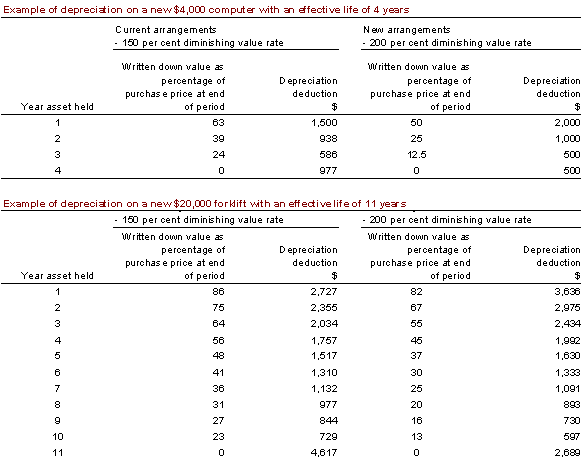The Government has tonight announced a significant improvement in Australia’s depreciation arrangements which will enhance the ability of Australian business to stay up to date with new technology.
The Government is raising the diminishing value rate under the uniform capital allowance (UCA) regime for determining depreciation deductions from 150per cent to 200per cent for all eligible assets. This is equivalent to a 33per cent increase in the allowable depreciation rate for these assets. By increasing the incentive to invest in new plant and equipment, the measure ensures businesses can keep pace with changes in technology and remain competitive.
The measure encourages efficient investment by ensuring that depreciation deductions for income tax purposes more closely reflect an asset’s actual decline in value. This will enhance productivity and help sustain strong economic growth.
Under the UCA regime, a taxpayer can use the diminishing value method for depreciating assets. Under this approach, taxpayers are able to claim a tax deduction for a fixed proportion of the written down value for an asset each year. The proportion they are able to write-off is determined by the diminishing value rate and the asset’s effective life. This reflects that the asset’s value declines more rapidly in the initial years in which the asset is held.
Increasing the diminishing value rate from 150per cent to 200per cent will increase the tax deductions that taxpayers can claim early in an asset’s effective life, reducing the cost of holding the asset in net present value terms.
The measure will apply to assets used for a taxable purpose acquired on or after 10 May 2006. This includes assets that taxpayers start to hold (for example, through leasing arrangements) for the purposes of the UCA regime.
Examples of how the new arrangements will affect tax depreciation deductions for new assets acquired after tonight are attached.
Legislation to give effect to the new rate, including appropriate integrity measures, will be introduced at the earliest opportunity.
Attachment A: Examples of how the increased diminishing value rate will affect tax depreciation deductions
The following examples illustrate how the increase in the diminishing value rate will affect the depreciation deductions that a business can claim. The increase in the diminishing value rate increases the deductions available to a business early in the asset’s effective life, when assets typically decline most in value.
The increase in the diminishing value rate complements the change to the uniform capital allowance (UCA) regime which the Government introduced in 2001. The UCA was a major reform which introduced arrangements under which depreciation deductions are based on the effective lives of assets rather than an arbitrary period (as applied under the previous accelerated depreciation arrangements).
As shown in the examples below, the increase in the diminishing value factor does not change the effective life over which the assets are depreciated or the total dollar amount written off over the asset’s effective life (assuming assets are scrapped at the end). However, the depreciation deductions in the early part of the asset’s effective life are higher, increasing their net present value and reducing a business’s financial cost of holding the asset.

